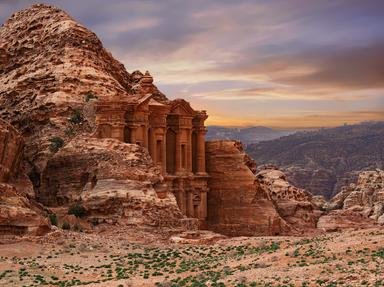Quiz Answer Key and Fun Facts
1. Let's begin our tour in northern Jordan! The site of Jerash has been occupied since the Neolithic Age, but the remains left behind by the Greeks and Romans are of special interest. What natural disaster occurred in the eighth century to destroy much of this ancient site?
2. As we travel south through Jordan, we reach the capital city of the country, where we plan to see the Temple of Hercules. What city have we entered?
3. Our next stop in Jordan is the city of Madaba, which is about nineteen miles west of the capital. Which of the following, important to the study of geography, is a famous artifact to see there?
4. The next location on our tour is Al-Maghtas, believed to be the place where Christ was baptized. It is located on the banks of which of the following rivers?
5. We are now traveling to a nearby ridge in the Abarim Range, where some believe God showed Moses the land of Canaan. What is the name of the ridge?
6. If you want to stay in Jordan's capital, it is possible to take a day trip to our next location. The site has several beaches and accommodations for tourists, along with a busy mineral processing industry. Where are we?
7. Moving south through Jordan, we are now entering an area called al-Karak, where construction began on Kerak Castle in the 1140s. That means that the castle was built during which period in Jordan's history?
8. The site of Petra, home of the ancient Nabataeans, is our next stop. Often called the Rose City, what type of stone was carved there?
9. We are excited to visit a site nearby that has a connection to the famous Lawrence of Arabia. It is a desert with beautiful rock formations. Where are we going?
10. We have reached the southern part of Jordan and are arriving at the Red Sea where the country's only port city is located. Which city is found there?
Source: Author
ponycargirl
This quiz was reviewed by FunTrivia editor
agony before going online.
Any errors found in FunTrivia content are routinely corrected through our feedback system.
